Galls or cecidia are a kind of swelling growth on the external tissues of plants. Plant galls are abnormal outgrowths of plant tissues, similar to benign tumors or warts in animals. They can be caused by various parasites, from viruses, fungi and bacteria, to other plants, insects and mites. Plant galls are often highly organized structures so that the cause of the gall can often be determined without the actual agent being identified. This applies particularly to insect and mite plant galls. The study of plant galls is known as cecidology.

Andricus kollari, also known as the marble gall wasp, is a parthenogenetic species of wasp which causes the formation of marble galls on oak trees. Synonyms for the species include Cynips kollari, Andricus quercusgemmae, A. minor, A. indigenus and A. circulans.

Cynipini is a tribe of gall wasps. These insects induce galls in plants of the beech and oak family, Fagaceae. They are known commonly as the oak gall wasps. It is the largest cynipid tribe, with about 936 to 1000 recognized species, most of which are associated with oaks. The tribe is mainly native to the Holarctic.

Amphibolips is an American genus of gall wasps in the family Cynipidae. There are about 57 described species in the genus Amphibolips with several others still undescribed.

Feron kingi, the red cone gall wasp, is a species of gall wasp in the family Cynipidae.
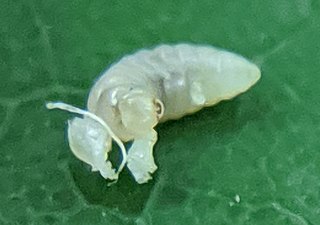
Acraspis erinacei, the hedgehog gall wasp, is a species of gall wasp in the family Cynipidae.
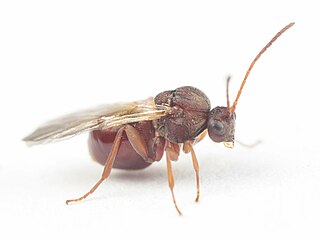
Heteroecus is a genus of gall wasps in the family Cynipidae. There are about seven described species in the genus Heteroecus.

Disholcaspis is a genus of gall wasps in the family Cynipidae. There are more than 40 species described in the genus Disholcaspis. Some Disholcaspis species induce galls that produce honeydew, a sweet liquid that attracts yellow jackets, ants, and bees. These insects then protect the galls from parasitic wasps.

Andricus quercusflocci is a species of gall wasp in the family Cynipidae.

Liposthenes glechomae is a species of gall wasp in the family Cynipidae. It is found in Europe and Northern Asia as well as North America where it and its host plant Glechoma hederacea are invasive, non-native species. Galls may appear as small red blemishes on foliage and develop into large green galls nearly as long as one of the plant's leaves.
Liposthenes is a genus of gall wasps in the family Cynipidae. There are at least two described species in Liposthenes.

Amphibolips quercusinanis, known generally as the larger empty oak apple wasp, is a species of gall wasp in the family Cynipidae.

Callirhytis is a genus of gall wasps in the family Cynipidae. There are more than 90 described species in Callirhytis. Wasps in this genus primarily induce wasps on oak trees in North America.
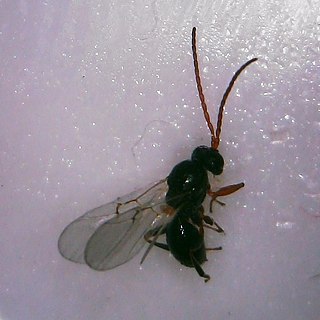
Andricus quercuspetiolicola, also called the oak petiole gall wasp, is a species of oak gall wasp in the family Cynipidae. Galls in which the larvae live and feed are formed along the midrib or petiole of white oak leaves.

Disholcaspis quercusmamma, the oak rough bulletgall wasp, is a species of gall wasp in the family Cynipidae. The quercus in its name is the genus name for oak, while "mamma" is Latin for "breast", presumably a reference to the "nipple" on the gall.
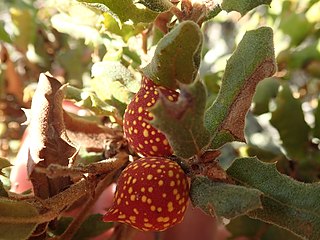
Burnettweldia plumbella, also known as the beaked twig gall wasp, is a species of gall wasp. Previously in the genus Disholcaspis, it was moved into a new genus, Burnettweldia, in 2021. This wasp induces galls on oak trees, including blue oak, leather oak, Muller's oak, and scrub oaks. The galls are up to 15 mm in diameter and brightly colored, coming in either red with yellow spots or green with yellow spots. Their name comes from the galls' pointed tip. Galls are formed in spring and summer, and adults emerge from them in November and December. The adult wasps are 3–4 mm in length.
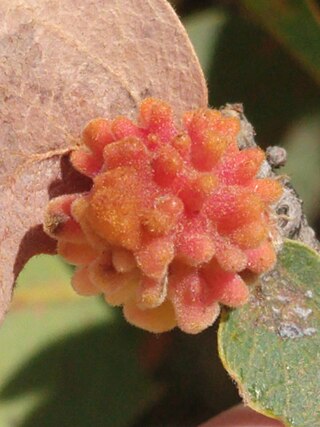
Burnettweldia corallina, formerly Disholcaspis corallina, the coral gall wasp, is a species of hymenopteran that induces galls on blue oaks in California in North America. The wasp oviposits at the base of leaf petioles. The detachable galls start out a mottled red-orange-yellow and over time darken to a deep brown and become brittle. This gall superficially resembles the oak galls induced by Besbicus heldae and Cynips quercusechinus.

Besbicus conspicuus, formerly Cynips conspicuus, also known as the fuzzy gall wasp, is a common species of cynipid wasp that induces globular stem galls on white oak trees on the west coast of North America. This gall is solid but for the central larval chamber. After the wasp emerges, beetles sometimes chew through the husk to consume the tissue inside. Besbicus conspicuus galls are sometimes mistaken for Disholcaspis washingtonensis galls. This wasp is found west of the Sierra Nevada range in California in North America.
Burnettweldia conalis, formerly Disholcaspis conalis, the witches' hat gall wasp, is a species of hymenopteran that induces stem galls on Oregon oaks in North America. The conical stem galls look like witches' hats lined up on a stick. The base of the detachable gall appears to grip the stem. Typical galls are 10 to 18 millimeters tall. Young galls are green, aging galls are fuzzy, and old galls are beige. The type species was collected in Sequoia National Park.
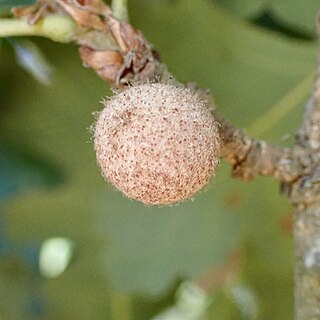
Burnettweldia washingtonensis, formerly Disholcaspis washingtonensis, the fuzzy gall wasp, is a species of hymenopteran that induces stem galls on white oaks on the Pacific coast of North America. The detachable galls have a little stem or neck, are gray or beige and fuzzy, and measure about 8–10 mm in diameter. The larval chamber is located at the center of the ball, the interior of which is otherwise chocolate brown. Older galls may appear pitted. The locally common galls induced by this wasp are sometimes mistaken for the galls induced by Besbicus conspicuus.















